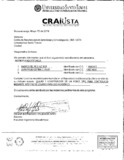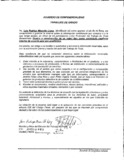Mostrar el registro sencillo del ítem
Diseño y construcción de un robot tipo puma controlado mediante interfaz de usuario para uso académico
| dc.contributor.advisor | Macilla López, Luis Rodrigo | spa |
| dc.contributor.author | Ospina Clavijo, Juan Pablo | spa |
| dc.contributor.author | Díaz Ríos, Andrés Felipe | spa |
| dc.date.accessioned | 2019-05-21T15:13:59Z | spa |
| dc.date.available | 2019-05-21T15:13:59Z | spa |
| dc.date.issued | 2019-05-20 | spa |
| dc.identifier.citation | Ospina Clavijo, J. P. y Diaz Ríos, A. F. (2019). Diseño y construcción de un robot tipo PUMA controlado mediante interfaz de usuario para uso académico [Tesis de pregrado]. Universidad Santo Tomás, Bucaramanga, Colombia | spa |
| dc.identifier.uri | http://hdl.handle.net/11634/16814 | |
| dc.description | En este documento se muestra el diseño y construcción de un robot tipo PUMA (Programmable Universal Manipulation Arm) de seis grados de libertad, que será utilizado como apoyo educativo en las clases de robótica de la universidad. Primero se han realizado los cálculos de cinemática directa e inversa, para lo cual se han utilizados los métodos de Denavit–Hartenberg y de desacoplo cinemático, los cuales son útiles para hacer más sencillo el análisis de los seis grados de libertad del robot PUMA al reducirlo a un sistema de tres grados de libertad. También se ha desarrollado el análisis dinámico del brazo robótico y se ha realizado su respectiva implementación. Las articulaciones están compuestas por servomotores dynamixel, los cuales cuentan con una conexión en bus, en la que se asigna un ID a cada actuador y que permite tener un solo conector en el circuito de control para cada familia de motores. El circuito diseñado permite la conexión de la fuente de alimentación y el Arduino Mega, que a su vez se comunica con los actuadores y la interfaz gráfica alojada en el computador. La interfaz gráfica fue diseñada en MATLAB y tiene como función principal el enviar y recibir datos desde y hacia los servomotores dynamixel, lo que permite el control de posición, velocidad y torque de estos; para esto se han implementado los cálculos de cinemática directa, inversa, generación de trayectorias, modelo dinámico y diagrama de simmechanics. Adicionalmente, la interfaz fue diseñada para que el usuario pueda ver la simulación del movimiento del robot, así como verificar las variables en el modelo matemático que permiten el movimiento de este. | spa |
| dc.description.abstract | This document shows the design and construction of a PUMA (Universal Programmable Manipulation Arm) robot of six degrees of freedom, which will be used as an educational support in the robotics classes of the university. First, direct and inverse kinematics calculations have been carried out, for which the Denavit - Hartenberg and kinematic decoupling methods have been used, which are useful to make easier the analysis of the six degrees of freedom of the PUMA robot when reducing it in a system of three degrees of freedom. The dynamic analysis of the robotic arm has also been developed and its respective implementation has been carried out. The joints are composed of dynamixel servomotors, which have a connection on the bus, in which an ID is assigned and each one a single connector in the control circuit for each engine family. The designed circuit allows the connection of the power supply and the Arduino Mega, which in turn communicates with the actuators and the graphic interface on the computer. The graphic interface was designed in MATLAB and its main function is the sending and receiving of data from and to the dynamixel servomotors, which allows the control of position, speed and torque of these; For this, the calculations of direct kinematics, inverse, generation of trajectories, dynamic model and simmechanics diagram have been implemented. In addition, the interface was designed so that the user can see the simulation of the movement of the robot, as well as verify the variables in the mathematical model that allows the movement of this. | spa |
| dc.format.mimetype | application/pdf | spa |
| dc.rights | Atribución-NoComercial-SinDerivadas 2.5 Colombia | * |
| dc.rights.uri | http://creativecommons.org/licenses/by-nc-nd/2.5/co/ | * |
| dc.title | Diseño y construcción de un robot tipo puma controlado mediante interfaz de usuario para uso académico | spa |
| dc.type | bachelor thesis | |
| dc.description.degreename | Ingeniero Mecatrónico | spa |
| dc.publisher.program | Ingenieria Mecatrónica | spa |
| dc.subject.keyword | PUMA robot | spa |
| dc.subject.keyword | Direct Kinematics | spa |
| dc.subject.keyword | Inverse kinematics | spa |
| dc.subject.keyword | Dynamic model | spa |
| dc.subject.keyword | Dynamixel servomotors | spa |
| dc.subject.keyword | Graphic interface | spa |
| dc.subject.keyword | Degrees of freedom | spa |
| dc.subject.lemb | Robots | spa |
| dc.subject.lemb | Interfases gráficas con el usuario (Sistemas para computador) | spa |
| dc.subject.lemb | Cinemática de la maquinaria | spa |
| dc.subject.lemb | Servomecanismos | spa |
| dc.type.local | Tesis de pregrado | spa |
| dc.rights.local | Abierto (Texto Completo) | spa |
| dc.type.version | info:eu-repo/semantics/acceptedVersion | |
| dc.rights.accessrights | info:eu-repo/semantics/openAccess | |
| dc.coverage.campus | CRAI-USTA Bucaramanga | spa |
| dc.description.domain | https://www.ustabuca.edu.co/ | spa |
| dc.relation.references | [1] J. Luo, Z. Bu, J. Han, "Study on 6-DOF puma robot based on theory of virtual compound joint," en IEEE 2nd Information Technology, Networking, Electronic and Automation Control Conference, ITNEC 2007, pp. 540-543. | spa |
| dc.relation.references | [2] A. Hendarto, Munadi, J. Setiawan, "ANFIS application for calculating inverse kinematics of programmable universal machine for assembly (PUMA) robot," The 1st International Conference on Information Technology, Computer, and Electrical Engineering, Semarang, 2004, pp. 35-40, 2014. | spa |
| dc.relation.references | [3] Carpio, C. Escandon y A. Marco, "Desing of a kinematic control model, for an anthropomorphic robot arm, applied to the teaching of industrial robotics," de 16th International Conference on Advanced Robotics (ICAR), Montevideo, 2013. | spa |
| dc.relation.references | [4] P. B. Mulik, "Optimal trajectory planning of industrial robot with evolutionary algorithm," de International Conference on Computation of Power, Energy, Information and Communication (ICCPEIC), Chennai, 2015. | spa |
| dc.relation.references | [5] V. Scheinman, "The Stanford Arm, Hand-Eye Project, Stanford Artificial Intelligence Laboratory. Computer History Exhibits," Manuscrito no publicado, 2000. | spa |
| dc.relation.references | [6] J. R. Surg, "Evolution of robotic arms," Journal of Robotic Surgery, 2007, p. 103–111. | spa |
| dc.relation.references | [7] Iñigo, E. V. Idiarte y Rafael, "Perspectiva histórica," de Robots industriales manipuladores, Barcelona, EDICIONES UPC, 2002, pp. 1-5. | spa |
| dc.relation.references | [8] David B. Samadi M., "History and the future of Robotic Surgery: Origins of Robotic Surgery," Manuscrito no publicado, 2008. | spa |
| dc.relation.references | [9] J. C. Vargas y W. A. Martínez, ¨Diseño y construcción de tres manipuladores robóticos," Bucaramanga, Universidad Santo Tomás, 2013. | spa |
| dc.relation.references | [10] Iñigo, E. V. Idiarte y Rafael, "Configuraciones principales," de Robots industriales manipuladores, Barcelona, EDICIONES UPC, 2002, pp. 5-10. | spa |
| dc.relation.references | [11] Billingsley, J. Wiley, Essentials of Mechatronics, 2nd ed, 2006. | spa |
| dc.relation.references | [12] A. Barrientos, "Cinemática del robot," de Fundamentos de robótica 2ª edición, McGraw-Hill, 2007, pp. 93-129. | spa |
| dc.relation.references | [13] A. Barrientos, "Algoritmo de Denavit-Hartenberg para la obtención del modelo cinemático directo," de Fundamentos de la robótica 2ª edición, McGraw-Hill, 2007, pp. 97-98. | spa |
| dc.relation.references | [14] S. K. Saha, Introducción a la robótica, Indian Institute of Technology: McGraw-Hill, 2010. | spa |
| dc.relation.references | [15] A. Barrientos, "Dinámica del robot," de Fundamentos de robótica 2ª edición, 1997, pp. 136-168. | spa |
| dc.relation.references | [16] J. J. Craig, Robótica Tercera edición., México: Pearson Educación, 2006. | spa |
| dc.relation.references | [17] A. Barrientos, "Control Cinemático," de Fundamentos de la robótica 2ª edición, 2007, pp. 169-200. | spa |
| dc.relation.references | [18] KUKA, "Industrial robots from KUKA," Datasheet modelo kr-3 en KUKA Robots, 2016. [En línea]. | spa |
| dc.relation.references | [19] KUKA, "KR QUANTEC," Datasheet modelo kr en KUKA Robots, 2016. [En línea]. | spa |
| dc.relation.references | [20] X. Zhao, "ArtStation," 2018. [En línea]. | spa |
| dc.relation.references | [21] ABB, "Industrial Robots," Catálogo ABB de robots industriales, [En línea]. | spa |
| dc.relation.references | [22] Y. He, S. Guo, L. Shi, S. Pan y Z. Wang, "Printing Technology-based an Amphibious Spherical Robot," IEEE, 2014. | spa |
| dc.relation.references | [23] K. Mitsuhashi, Y. Ohyama, H. Hashimoto y S. Ishijima, "Production and Education of the Modular Robot Made by 3D Printer," IEEE, 2015. | spa |
| dc.relation.references | [24] P. Rühs, F. Coulter y A. Studart, eds, "3D printing of robotic soft actuators with programmable bioinspired architecture," Nature Communications, 2018. | spa |
| dc.relation.references | [25] K. Kurashige, R. Knauf, E. Damiani, eds, "Design of Counseling Robot for production by 3D printer," de 13th International Conference on Signal-Image Technology and Internet-Based Systems, Jaipur, India, 2017. | spa |
| dc.relation.references | [26] P. I. Corke, "A Simple and Systematic Approach to Assigning Denavit–Hartenberg Parameters," IEEE Transactions on Robotics, vol. 23, nº 3, pp. 590-594, 2007. | spa |
| dc.relation.references | [27] Z. Pilch, J. Domin, A. Szłapa, "The impact of vibration of the 3D printer table on the quality of print," de 2015 Selected Problems of Electrical Engineering and Electronics (WZEE), Kielce, Poland, 2015. | spa |
| dc.relation.references | [28] Schwarz U, Teschner M, Hammer B, Schmelzeisen R., eds, "Manufacturing splints for orthognathic surgery using a three-dimensional printer," IEEE, 2015. | spa |
| dc.relation.references | [29] M. Alimanova, A. Zholdygarayev, A. Tursynbekova y D. Kozhamzharova, "Overview of a Low-cost Self-Made 3D Food Printer," de 13th International Conference on Electronics, Computer and Computation (ICECCO), Abuja, Nigeria , 2017. | spa |
| dc.relation.references | [30] A. Barrientos, "Elementos terminales," de Fundamentos de robótica 2ª edición, McGraw-Hill, 2007, pp. 44-46. | spa |
| dc.rights.coar | http://purl.org/coar/access_right/c_abf2 | |
| dc.subject.proposal | Robot PUMA | spa |
| dc.subject.proposal | Cinemática directa | spa |
| dc.subject.proposal | Cinemática inversa | spa |
| dc.subject.proposal | Modelo dinámico | spa |
| dc.subject.proposal | Servomotores Dynamixel | spa |
| dc.subject.proposal | Interfaz gráfica | spa |
| dc.subject.proposal | Grados de libertad | spa |
| dc.type.category | Formación de Recurso Humano para la Ctel: Trabajo de grado de Pregrado | spa |
| dc.type.coar | http://purl.org/coar/resource_type/c_7a1f | |
| dc.description.degreelevel | Pregrado | spa |
| dc.identifier.repourl | repourl:https://repository.usta.edu.co | spa |
| dc.type.coarversion | http://purl.org/coar/version/c_ab4af688f83e57aa | |
| dc.type.drive | info:eu-repo/semantics/bachelorThesis |




















